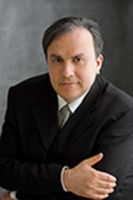Bartok, Brahms and Bronfman
MKary Ellyn Hutton
Posted: Mar 7, 2009 - 12:52:25 PM in
reviews_2009

Yefim Bronfman
|
One wonders how the 1925 Cincinnati Symphony audience responded to Bela Bartok’s Dance Suite.
It was the U.S. premiere, led by CSO music director Fritz Reiner, a strong advocate for his fellow Hungarian’s music. Some idea might be gleaned from local response to Bartok’s Piano Concerto No. 1, performed by Reiner and the CSO with Bartok as soloist on Feb. 24, 1928 at Emery Auditorium:
“The lobby was fairly blue with acrimonious discussion of modern composition in general and Bela Bartok in particular,” wrote critic Robert Aura Smith (the source of Smith’s review is not given in the archival source from which this is taken). Smith himself praised Reiner and the orchestra “for pulling us out of the rut and giving us something to think about.”
The Dance Suite, a set of folk-song-inspired dances composed for the 50th anniversary of the unification of Buda and Pest, received a warm reception Friday morning (March 6) at Music Hall as part of the CSO’s ongoing Bartok Project. The concert, led by music director Paavo Järvi, also included Bartok’s Two Portraits, Op. 5, a kind of “before” and “after” reaction to his unhappy love affair with violinist Stefi Geyer. The second half of the program comprised Brahms’ Piano Concerto No. 2 with guest artist Yefim Bronfman.
It was a potent mix and left members of the audience: a) calling for an encore from Bronfman and b) exchanging (pleasantly surprised?) comments about Bartok, a composer who still meets with hesitation on the part of some listeners.
Soloist in the first of the Two Portraits, “Ideal,” was concertmaster Timothy Lees, who brought Bartok’s tender side meltingly to life. Essentially the first movement of his First Violin Concerto, “Ideal” pulses with the vulnerability of young love, affording a non-stereotypical glimpse of the composer. Lees shaped the soft, opening theme with a velvet touch, taken up by the CSO strings and winds in a virtual odyssey of the heart. Two Portraits recalls Berlioz’ similarly love-besotted “Symphonie fantastique,” ending with “Grotesque,” where the beloved is skewered in snarly, oompah rhythms and mocking winds akin, in spirit if not in length (three minutes and based on one of his Bagatelles for piano), to the witchy finale of Berlioz’ “fantastique." Leading the thumb-nosing here was the CSO’s nimble associate principal clarinetist Jonathan Gunn.
“Dance Suite” (performed by Järvi and the CSO in 2006) got a performance brimming with energy, color and technical brilliance. The five dances stood out in bold, primary colors, alternating with a ritornello (short, recurring passage) of more gentle, pastel persuasion. Principal bassoonist William Winstead (a standout throughout the work) set the tone at the outset with a chortling figure that was expanded and exploited by all.
Juices really started to flow in the second dance (Allegro molto), where Romanian-born principal trombonist Cristian Ganicenco weighed in with some raucous, in-your-face slides. Keyboardists Michael Chertock and Heather MacPhail attended skillfully to the important piano/celesta parts, piano four hands in the third dance, a merry Allegro vivace, where MacPhail had to make a quite dash from her post to join Chertock.
Arab influence made itself felt (Bartok collected folk song in Turkey and North Africa as well as Eastern Europe) in the fourth dance (Molto tranquillo), where English hornist Christopher Philpotts and bass clarinetist Ronald Aufmann joined in some darkly evocative solos. The final dance recalled Stravinsky (“Rite of Spring” about vernal rites in primitive Russia) and at one point Liszt, where it suddenly threatened to break into his Hungarian Rhapsody No. 2. Järvi built the 18-minute suite to a savory conclusion with a final percussive blow by the full orchestra.
Bronfman is both surefire box office and surefire musician and he delivered on both at the Friday matinee, which saw Music Hall fuller than usual. His Brahms was magisterial, an expression of classical romanticism at its finest with nothing under or over-stated. In every way, he was matched by Järvi, with whom he shared total rapport. (In his pre-recorded “First Notes” video, shown prior to all of his concerts, Järvi called Bronfman “a monster pianist,” adding “I mean that in the most endearing way.”)
Bronfman’s command is so complete that you almost take it for granted. There was sweep and grandeur in the opening movement (announced with nobility by associate principal French hornist Thomas Sherwood) and a kind of touching turbulence in the second.
The third movement brought one of the surprises of the concert, visiting principal cellist Ilya Finkelshteyn, principal cellist of the Baltimore Symphony. Prime candidate to succeed CSO principal cellist Eric Kim (leaving this season to join the faculty of the Indiana University’s Jacobs School of Music in Bloomington), Finkelshteyn lit up the Andante Cantabile like none within this listener’s memory, recent or otherwise. His smooth technique, limpid phrasing and gorgeous tone made one hang on every note. As such, he was a perfect complement to Bronfman.
The finale, grazioso with torrents of notes at the end, brought the concert to a thrilling conclusion. Although Bronfman graciously rose to acknowledge applause at the end of the first movement and shared the final ovation demonstrably with Järvi and his players, there was no encore.
Repeat (encore?) is 8 p.m. March 7 at Music Hall. Go at 7 and hear a pre-concert “Classical Conversation” with Järvi and CSO assistant conductor Kenneth Lam.
Note: A contribution of canned goods to the Freestore Foodbank (there are bins at Music Hall) will buy admission to the concert for only $10, part of an industry-wide initiative by American orchestras to feed the hungry during the economic turn down.


